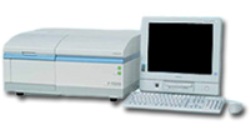Feb 1 2010
The F-7000 fluorescence spectrophotometer achieves a high sensitivity (S/N 800:RMS), ultra-high-speed (60,000nm/min) wavelength scan at the highest level in its class, with a wide dynamic range up to 6 digits. Furthermore, it is applied to research, development, and quality control in a broad range of fields, such as industrial materials, life sciences, and biotechnology.
 F-7000 Fluorescence Spectrophotometer
F-7000 Fluorescence Spectrophotometer
The 4-turret accessory used in this experiment automatically measures, by computer control, the time course of the fluorescence intensity at regular time intervals through 4 rotating cells installed in a turret. A reaction trace for an enzyme is used to measure the time course of fluorescence intensity in plural samples. Previously, the time course was measured for one sample at a time, so the measurement time required was proportional to the number of samples. Application of the automatic 4-turret accessory reduces measurement time.
An enzyme assay was applied to ethanol measurement in this experiment. The amount of ethanol in the fish is increased according to a decline of the freshness, so this measurement is referred to as the freshness index. Ethanol is usually measured with a spectrophotometer. When ethanol is present in trace amounts, a low concentration measurement is performed with a fluorescence spectrophotometer. In this experiment, the general enzyme assay reagent “F-kit ethanol (J.K.International)” was used. In addition to the enzyme assay, a spectrophotometer was used to measure ethanol amounts. The analysis conditions were optimized, and an analytical curve for a standard solution was created